|
 Tubulicrinis umbraculus Tubulicrinis umbraculus
SynonymsPeniophora umbracula
Peniophora hamata
BiostatusPresent in region - Indigenous. Endemic
Images (click to enlarge)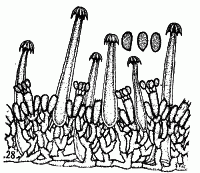
Caption: Fig. 28. Peniophora umbracula G.H.Cunn. Transverse section, x 500. Spores, x 1000. | 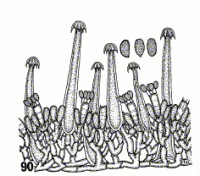
Caption: FIG. 90. Tubulicrinis umbracula. Showing the naked cystidia tapering to apices
bearing fused crystals arranged in the form of minute parasols, and elliptical or
obovate spores. | 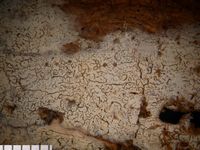
Owner: J.A. Cooper | 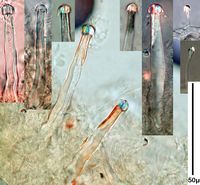
Caption: cystidia
Owner: J.A. Cooper | 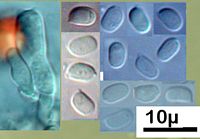
Owner: J.A. Cooper | 
Caption: Tubulicrinis umbraculus, BCP 3008
Owner: B.C. Paulus | 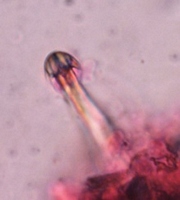
Caption: Tubulicrinis umbraculus, BCP 1591
Owner: B.C. Paulus | 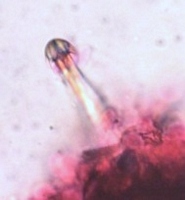
Caption: Tubulicrinis umbraculus, BCP 1591
Owner: B.C. Paulus | 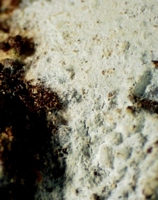
Caption: Tubulicrinis umbraculus, BCP 1591
Owner: B.C. Paulus | 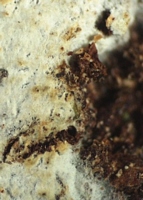
Caption: Tubulicrinis umbraculus, BCP 1591
Owner: B.C. Paulus | 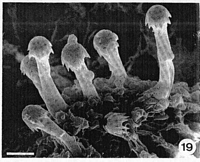
Caption: Fig. 19 Peniophora umbracula [=Tubulicrinis umbraculus] (PDD 13660), cystidia. Scale =10 µm. |
Article: Stalpers, J.A.; Buchanan, P.K. (1991). Type studies of the species of Pellicularia and Peniophora described by G.H. Cunningham. New Zealand Journal of Botany 29(3): 331-340 (http://www.rsnz.org/publish/abstracts.php).
Description: Hyphae hyaline, much branched, short-celled, clamped at all septa. Lyocystidia strongly
projecting, radicate at the base, gradually, tapering, broadly rounded at the apex and covered
by a large umbrella-shaped crystalline head, 6-8.6 µm across, not soluble in KOH; cystidium
wall hyaline, smooth, not amyloid, unevenly thick-walled up to 3.7 µm wide; wall frequently
asymmetrically thickened, dissolving in 10% KOH; cystidia 38-70 x 6.8-10 µm. Miniature
cystidia of the same shape, possibly juvenile forms, up to 4-7 x 6 µm, with umbrella-shaped
crystalline head 5 µm across. Basidia barrel-shaped, with four sterigmata, 12.5-17.5 x 5-7
µm. Spores hyaline, smooth, oblong-ellipsoid, 4.5-6.5 x 2.5-3.5(-4.5) µm, not amyloid.
Notes: The conspicuous capitate lyocystidia of T. umbraculus are found in only two other species, T.
hamatus (H.S. Jackson) Donk and T. corneri Jülich. Both T. umbraculus and T.
hamatus have
an effused, even hymenophore, whereas that of T. corneri is odontioid to hydnoid (Jülich
1979). Oberwinkler (1966) and Jülich (1979) considered T. umbraculus and T. hamatus
conspecific, but Weresub (1961) found that the holotypes of these two species could be
distinguished by spore shape; spores of T. hamatus were described as "broadly ellipsoid,
5.5-7(-8.2) x 4-5.5 µm". Weresub (1961) and Cunningham (1955) also noted that basidia of T.
hamatus are larger (up to 30 x 8.5 µm) than those of T. umbraculus. Furthermore, the
cystidia, while similar with the conspicuous crystalline head, apparently differ in wall
thickening; in T. hamatus the walls were rarely up to 2-3 µm thick and not reported to be
asymmetrically thickened (Weresub 1961).
In confirming the careful observations made by Weresub (1961) for T. umbraculus and
accepting her description of T. hamatus, we consider that separation of the two species is
justified on the basis of morphological differences in cystidia, basidia, and spores.
Article: Cunningham, G.H. (1963). The Thelephoraceae of Australia and New Zealand. New Zealand Department of Scientific and Industrial Research, Bulletin 145: 359 p. Wellington:.
Description: Hymenophore annual, membranous, adherent, effused forming irregular colonies, 1-4 x
0.5-2 cm; hymenial surface cream, even although at first often porose, not creviced;
margin thinning out, arachnoid, white, adherent. Context white, 30-50 µ thick, basal layer
of a few repent hyphae, intermediate layer of scanty mainly erect hyphae; generative
hyphae 4-5 µ diameter, walls 0.5 µ thick, naked, often inflated between septa, with clamp
connections. Cystidia arising from the basal layer or subhymenium and projecting to 50 µ,
cylindrical, 35-70 x 10-12 µ, tapering to apices where each is capped with a crystalline
body to 8 µ diameter, resembling a miniature parasol, with radiating ridges terminating in
acute spines, walls naked, thickened to 3 µ. Hymenial layer to 20 µ deep, a loose palisade
of basidia, paraphyses, and cystidia. Basidia subclavate, 10-14 x 5-6 µ, bearing 4 spores;
sterigmata slender, erect, to 5 µ long. Paraphyses subclavate, 8-10 x 3.5-4 µ. Spores
elliptical, sometimes flattened on one side, or obovate, apiculate, 5-6 x 3-3.5 µ, walls
smooth, hyaline, 0.2 µ thick.
Habitat: HABITAT: Effused on bark or decorticated dead branches.
Distribution: TYPE LOCALITY: Stewart Island, Otago, New Zealand.
DISTRIBUTION: New Zealand.
Notes: Cystidia project for the greater part of their length, are moderately thick-walled, taper from
bases, and bear upon apices caps of fused crystals which resemble miniature parasols. The
exterior of each cap is ribbed and ribs terminate in acute down-pointed spines. But one
other species with such a feature has been described, T. hamata (Jacks.) Donk, which
differs in the larger basidia and differently shaped spores. Walls of cystidia are naked and
are destroyed with solutions of potassium hydroxide although the apical `caps remain
inaltered.
Article: Cunningham, G.H. (1955). Thelephoraceae of New Zealand. Part VI. The genus Peniophora. Transactions of the Royal Society of New Zealand 83(2): 247-293.
Description: Hymenophore annual, membranous, adnate, effused forming small irregular colonies 1-4 x
0.5-2 cm; surface cream, even though at first often porose, not creviced; margin thinning out,
arachnoid, white, adnate. Context white, 30-50 µ thick, basal layer of a few repent hyphae,
intermediate layer of scanty mainly upright hyphae 4-5 µ diameter, walls 0.5 µ thick, hyaline,
naked, branched, septate, often inflated between septa, with small inconspicuous clamp
connexions. Hymenial layer to 20 µ deep, a loose palisade of basidia, paraphyses and cystidia.
Basidia subclavate, 10-14 x 5-6 µ, 4-spored; sterigmata slender, upright, to 5 µ long.
Paraphyses subclavate, 8-10 x 4 µ. Cystidia arising from the basal layer or subhymenium and
projecting to 50 µ, cylindrical, 35-70 x 10-12 µ, naked, bases rounded, tapering to apices
where each is capped with a crystalline body, to 8 µ diameter, resembling a minute parasol,
with radiating ridges terminating in acute spines, walls thickened to 3 µ. Spores elliptical,
sometimes flattened on one side, or obovate, apiculate, 5-6 x 3-3.5 µ, walls smooth, hyaline,
0.25 µ thick.
Habitat: HABITAT. Effused on bark or decorticated dead wood.
Distribution: DISTRIBUTION. New Zealand.
Notes: Cystidia delimit the species. They project for the greater part of their length, are moderately
thick-walled, taper from the bases, and bear upon the apices caps of fused crystals which
resemble minute parasols. The exterior of each cap is ribbed and ribs terminate in acute
down-pointed spines. But one other species with such a feature has been described-namely, P.
hamata Jacks., which differs in the larger basidia and differently shaped spores. Stems of the
cystidia are naked, and destroyed with potassium hydroxide though apical caps remain
unaltered.
|